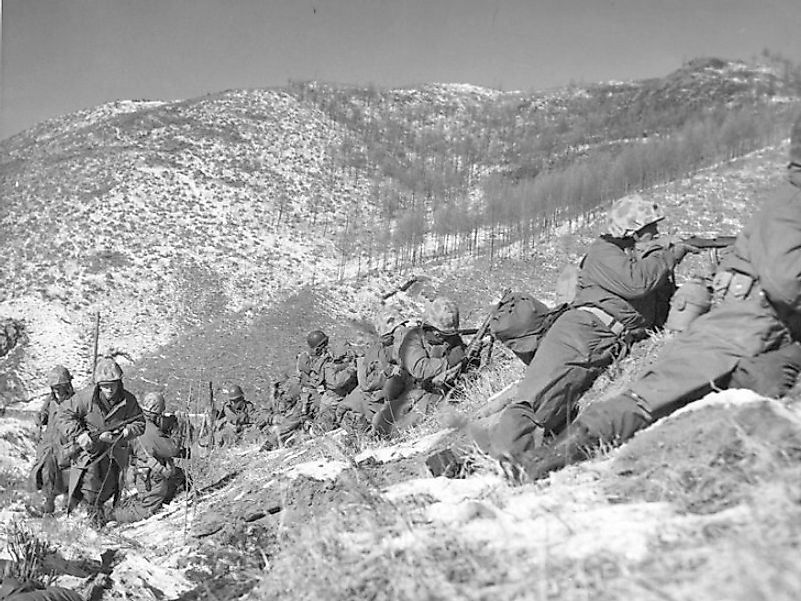Battle Of Chosin Reservoir - Korean War

5. Background
The Battle of Chosin Reservoir was one of the crucial engagements from the Korean War. Fought from November 27th until December 13th in 1950, the battle took place in the hills and valleys that surrounded the frozen Chosin Lake in the North Korean province of South Hangyong. The engagement started when the American forces of the 1st Marine Division and the X Corps (who were pushing north in pursuit of the Chinese) saw themselves unexpectedly surrounded by an entire Chinese Army Group. Over the following two weeks, the Americans managed to break out of the Chinese encirclement and reach the coast where they were evacuated.
4. Makeup
Chosin Reservoir was the first major engagement in the Korean War between Chinese and American forces. The American forces at the Chosin Lake were composed of units from the US Army's X Corps, commanded by General Edward Almond, and the 1st Marine Division, commanded by General Oliver Smith. The Chinese forces involved in the battle were the 9th Army Group, which was commanded by General Song Shi-Lun. Shi-Lun’s forces counted among them 67,000 men. They were well-positioned around high ground, and ready to face the 30,000 American soldiers that were scattered over the surrounding area.
3. Description
Both sides employed radically different military doctrines to reach their goals. The US forces relied on their material advantages, making good use of air superiority, tank support, and an overwhelming number of artillery missions to crush the enemy. Meanwhile, the Chinese army had developed from their experience fighting as guerrillas during the 20 years long Chinese Civil War. The Chinese had learned to offset their material shortcomings by exploiting the mobility that their independence from long supply lines, a must-have for a modern mechanized army, awarded them. In the frozen hills of Korea, the Chinese made good use of these tactics by attacking and retreating seemingly out of nowhere. The horrors of the battle were worsened by the bitterly cold weather, as temperature approached -40 degrees Fahrenheit (-40 degrees Celsius).
2. Outcome
On November 27th, the Chinese launched attacks against American forces moving through the road that lead to Koto-Ri. Caught by surprise, the American forces were surrounded and cut-off into several small pockets. The Marines desperately defended their positions against continual Chinese assaults but risking to be overrun, the Americans started retreating on December 6th, using air strikes to support their breakout from the Chinese blockade and escaping to the South. The objective of the retreat was the city of Hungnam where they arrived on December the 11th. Chosin Reservoir was a costly victory for the Chinese, costing them almost 50,000 casualties, while the Americans suffered 17,843 casualties.
1. Significance
Chosin Reservoir was a shocking defeat for the UN military forces, and a rude awakening for the Americans, who had underestimated Chinese capabilities. The battle at Chosin Reservoir put an end to the United Nations' push to reach the Chinese border, as they saw themselves forced to retreat all the way back to their starting line at the 38th Parallel to piece back together their defenses. The Chosin Reservoir showed the UN high command that the war couldn't be won by military force alone. As a result, in the following years, the UN would limit its objectives to guaranteeing the independence of South Korea rather than attacking the Communists north of the 38th Parallel near the Chinese borders.
Despite the loss of territory, the U.S. forces remained more intact and less ravaged than their Chinese counterparts. 17 Americans from 3 military branches received Medals of Honor for their valor in the engagements. The UN forces who served that day live on forever in military history as the ‘Chosin Few’. Many of the casualties were later exchanged to receive burials and honors between the UN and Communists, in what would become known as ‘Operation Glory’. Many of the unidentified bodies were buried at Honolulu’s Punchbowl Crater in the National Memorial Cemetery of the Pacific.











